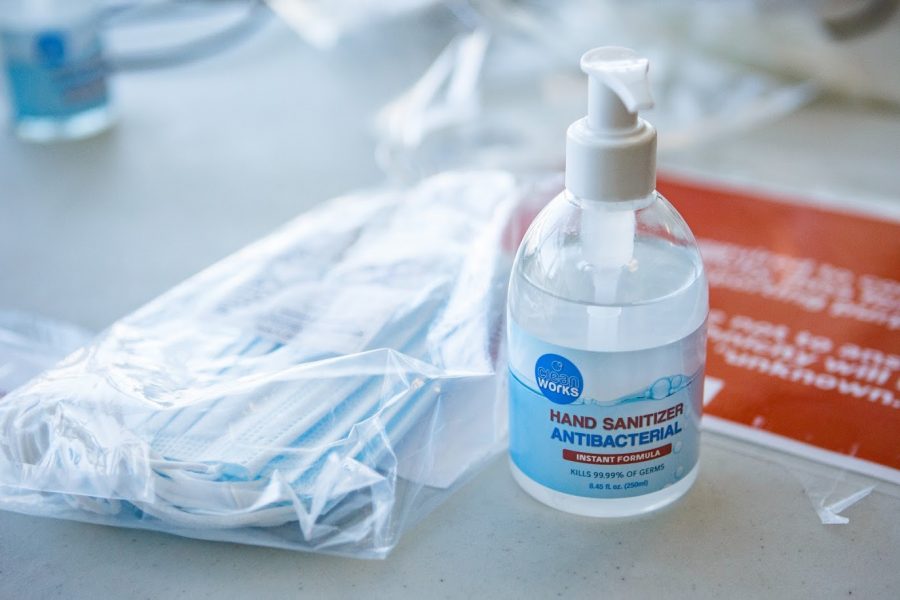Chemosensory losses could indicate COVID-19 infection
Personal protective equipment materials lay on a table at the ARC COVID-19 testing site on Feb. 1. A loss of sense of smell can be an indicator of COVID-19 infection.
March 8, 2021
The onset of the COVID-19 pandemic more than one year ago instigated a number of new research projects, particularly bringing attention to the underrated olfactory and gustatory senses, according to the The New York Times. Our senses of smell and taste are considered minor senses compared to vision and audition, according to M. Yanina Pepino, assistant professor in the Department of Food Science and Human Nutrition and the Division of Nutritional Sciences at the University of Illinois. But, the chemical senses, or the senses of taste and smell, have become an important red flag for COVID-19 infection, Pepino says.
For many, the idea of losing one’s sense of smell seemed unworthy of attention until cases of anosmia continued to appear as the COVID-19 pandemic raged on. Anosmia, a disorder characterized by a complete loss of smell, is thought to affect at least two million people across the United States alone. Feb. 27 marked International Anosmia Awareness Day, a day Pepino believes deserves more attention. Pepino is one of the hundreds of researchers affiliated with the Global Consortium for Chemosensory Research trying to understand both our sense of smell and sense of taste a little bit better.
The GCCR, developed around March of 2020, was borne as a result of increasing reports of chemosensory losses due to COVID-19 infection. According to Pepino, who is one of 11 members of the GCCR Leadership team, the goals of the GCCR are to understand the chemosensory issues reported alongside respiratory illness, particularly COVID-19, to increase awareness of the chemical senses and to make science and research more transparent and equitable worldwide.
“The GCCR was created out of the need for understanding what was going on with taste and smell as these senses relate to Covid,” Pepino said. “We want to increase knowledge and awareness of the senses of taste and smell, but we are also a group of people who want to advance trust in science through open science.”
All hypotheses and data the GCCR creates and collects are pre-registered in the Open Science Framework, and they use statistical packages that are accessible to everybody to ensure that all countries can utilize the same tools, regardless of socioeconomic background.
Get The Daily Illini in your inbox!
“It’s not just for countries with more funding for science,” Pepino said. “That’s a big plus of this consortium. I also like that it is so diverse, not only in language and culture, but also through promoting interdisciplinary science.”
Affiliates of the GCCR range from researchers and physicians to patient advocates, artists and perfumers.
Loss of smell is a common side effect of nasal inflammation and congestion caused by cold and flu viruses, but researchers and physicians across the globe now affiliated with the GCCR began to notice COVID-19 patients losing their sense of smell without having the expected physical blockage in their nose that would normally prevent scents from reaching their olfactory receptors.
The GCCR’s efforts toward investigating the chemical senses in relation to COVID-19 infection have led to the development of a number of tools anyone over the age of 18 can use to detect changes in their gustatory and olfactory senses. There is a seven-day challenge and a longer, 30-day challenge, both of which ask participants to rate the taste and smell of the same product every day.
For example, if a participant chooses coffee as their daily beverage, they will be asked each day to rank the bitterness, sourness, sweetness and other elements of their drink. At the end of the challenge, they will be presented with a graph depicting changes in their chemical senses. Any stark differences may alert a participant to potentially concerning alterations in their ability to taste and smell, something that might encourage someone to see a healthcare provider or at least self-quarantine as a precautionary measure.
The work of researchers at the GCCR has resulted in the publication of two papers in the journal, “Chemical Senses.” Their first paper indicates the association discovered between COVID-19 and a sudden loss of sense of smell, taste and chemesthesis. The second publication shows that a loss of sense of smell is the best predictor for COVID-19, even better than a fever or cough.
Moving forward, the GCCR has begun to investigate the chemical senses beyond the realm of COVID-19. They want to uplift the voices of those born without the ability to taste and smell and continue to conduct research in an equitable manner. Global equity is something Pepino strongly advocates for, as she has seen the pandemic — and now vaccine distribution — highlight socioeconomic disparities worldwide. Disadvantaged nations and individuals will continue to suffer for a much longer time than privileged ones, she says.
On top of that, some countries and people who helped develop the vaccine are now the same people at the end of the line to receive it, according to Pepino, which highlights important global inequities in research.
“Although we are in 2021, I feel like we are going through the same mistakes that we’ve seen in the history of research ethics on who gets exposed to the risks and who gets the benefits of the research,” Pepino said. “Through the GCCR, I’m learning a lot about how to make science more equitable, more transparent and how to reach populations, whether or not they are a developing country without as many resources.”
Shivali is a senior in AHS.







